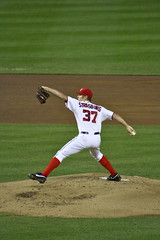Like a goalie in hockey and a quarterback in football the pitcher in baseball has the most impact on if his team wins or not, and there was a time when a pitcher had even more control. Once the role of the starting pitcher was to pitch all nine innings and the only reason they didn’t was because they massively failed. The Win stat however doesn’t measure how well a pitcher pitched. What it does measure is if a pitcher pitched at least five innings, left with their team in the lead, and no reliever surrendered the lead. Over a long enough time line the pitcher Win stat still will inform on who was good but the win stat is a symptom of a pitcher being good and not the reason.
To more accurately measure what a pitcher is doing ERA can be used, but there are still issues with ERA. Again, like the Win stat, on a long enough time line ERA will inform us a great deal of how a pitcher has done for their career, but for one season even bad pitchers can have good Win or ERA totals. What ERA measures is the earned run average that a pitcher would have given up had he gone nine. An earned run is any run that crosses the plate not due to an error, and an error is decided upon by an official scorer. Beyond that defense can play a great role in ERA. A slow roller to the left of a bad fielder could get by while a smash deep in the hole can be converted to an out by a good fielder. A good pitcher in front of a bad defense will end up with more of his balls in play being hits than a bad pitcher in front of a good defense.
Enter Voros McCracken in 1999 who looked at the fluctuations in ERA and decided a better method was needed. What he invented become known as DIPS or Defense Independent Pitching. His theory was that the events a pitcher has the greatest control over are the ones that do not involve a defense. He looked at strikeouts, walks, homeruns, and hit by pitch as events that the defense did not have a hand in and thus more controllable to the pitcher. What he found was that strikeout, walk, and homerun rates were more consistent during a pitchers career than ERA and a better way to measure what a pitcher is doing.
What we get from this is the stat FIP which stands for Fielding Independent Pitching and weights the outcomes of the pitching events of strikeouts, walks, homeruns, and hit by pitch and gives a total similar to ERA. Because of this some people look at FIP as a predictive or theoretical stat. It is neither. It is a stat that measures how good a pitcher is at not walking batters, generating his own outs via strikeout, and not giving up homeruns. At times during a season ERA and FIP will meet, but because they measure two different things that isn’t always the case, and some pitchers have other abilities that FIP doesn’t measure.
As soon as McCracken’s theory went public people disagreed. Not all balls in play are created equal and in some cases, as with sinkerball and knuckleball pitchers, the quality of contact determines to what percent a ball in play becomes a hit or an out. These types of pitchers are not common, but it is by no accident that Charlie Hough has a career .250 BABIP and his 3.75 ERA is significantly lower than his 4.29 ERA. Likewise but to a lesser degree the sinker is also a low BABIP pitch with Tim Hudson’s sinker drawing a .273 BABIP and Brad Ziegler’s a .278, because of this they both have ERAs slightly lower than their FIPs at 3.42/3.78 and 2.44/3.35 respectively.
Baseball has not stopped studying the pitcher’s ability to control the quality of contact on a ball in play and how that relates to BABIP. The findings are that pitchers have some control over the quality of contact, but batters have more control. Bat speed and the speed of the ball off the bat is the greatest indicator of if a ball in play will become a hit or an out. Think about the games you have seen and a hard hit line drive vs. an 11 hopper in the infield. The speed that the ball travels has a great deal to do with whether it is a hit or not. Mike Fast formerly of Baseball Prospectus and currently of the Houston Astros studied this in November of 2011 and wrote a series of excellent articles on who controls the quality of contact and how quality of contact effects BABIP.
The softest hit ground ball still has a 10% chance to become a hit while a strikeout a 0% chance. At the end of the day the best thing for a pitcher to do is to not walk batters, strike them out, and not give up homeruns, but not all pitchers have that skill set, and understanding the others is important. This is where baseball is headed. Understanding the physics of the game. Just how will a curveball low in the zone traveling at 83 MPH react when it hits off the end of a bat traveling 75 MPH. But until this full understanding is reached, and perhaps even after, FIP is the best stat known for measuring how good a pitcher is at doing the things a pitcher has the most control over.

Nice to see the the SABR community bursting into the mainstream.
I take it that comment was beemed to us from 1994